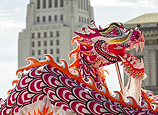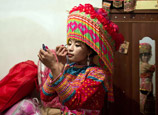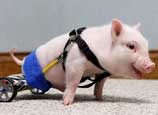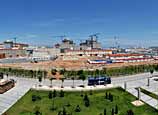
"In the 1960s and 1970s, being driven in a Hongqi ranked, alongside visiting Chairman Mao and staying at Diaoyutai State Guesthouse, as one of the highest privileges for foreign dignitaries," Luo says.
In 1961, Indonesian President Sukarno paid a visit to China and was driven along Tian'anmen Square in a Hongqi CA72 Cabriolet to salute cheering crowds of Chinese people. At first he stood and then, after he got tired, he stepped onto the backseat, seated himself on the back of the car and continued to wave.
Premier Zhou noticed that Sukarno made a good impression and called for a review car in which leaders and guests could comfortably stand up or sit down.
One year later, First Automobile Works turned out a limousine that fit the bill. Passengers could press a button and the seat would rise so someone could appear to be standing.
Luo's collection includes a special car, containing a stretcher bed and curtains, for Zhou who was struggling with cancer. Zhou could be driven around but no one could see him.
Owner Luo was born in the countryside in north China's Hebei Province and went into business when he was age 24. He became wealthy by running a transport company, a waste disposal site and auto repair shop.
In 1978, when private cars were a rarity in China, Luo started collecting classic cars from around the world and has poured tens of millions of yuan into his collection.
"I can't count how much I have spent, but to me the cars are priceless," Luo says.
His started driving a Hongqi in 1998 when the Louis Vuitton Classic Car Rally came to China. Luo drove the Hongqi CA770, with three rows of seats, from Dalian in Liaoning Province to Beijing. He was the only Chinese driver.
At that time he had around 60 classics to choose from, including may high-performance foreign autos.
"But I chose the Hongqi because a Chinese entrant should drive his own Chinese car in the rally," Luo says.
Luo's first Hongqi is a V8 CA770 that belonged to Marshal Nie (1899-1992), one of the 10 marshals in the People's Liberation Army.
Luo says he was moved to tears during the rally as spectators shouted, "Long live China! Long Live Hongqi!" Crowds lined the streets, cheering and taking photos, filled with pride in the Chinese-made limo.
"The rally changed me from an ordinary fan of classic cars to a lover of Chinese-made limousines, especially the Hongqi," Luo says.
Since then his aim is to let more people know about the history and value of Hongqi.
After the rally, Luo sold his businesses and house and immersed himself in collecting Chinese classic autos. His obsession used to anger his family, but nothing could stop him.
In 2005, he went to Beijing to build a classic car museum, but at first he was rebuffed.
In 2009, after spending 8 million yuan (US$1.2 million), he opened a two-story building covering 3,000 square meters. He went from being a multimillionaire to a church mouse.
"It takes a certain kind of strength to collect these cars, and a very different kind of energy to promote them and let people know about their value," he says.


















 A 9-year-old son takes good care of his amputee mother: "adults have a priority over delicious meals"
A 9-year-old son takes good care of his amputee mother: "adults have a priority over delicious meals"


![]()
